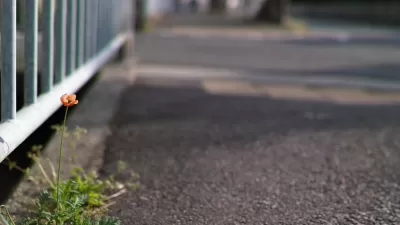Michael J. Coren has a preview of an MIT report that lays out the economic and environmental benefits of stiffer pavement.
It's not much, but roadway asphalt has a springiness to it. As cars roll over asphalt they create indentions about .0003 inches deep. As a result, cars are essentially going up a tiny, yet endless, hill.
"A study by MIT civil engineers found stiffening the nation's pavements could cut fuel use by 3%, the equivalent of 273 million barrels of crude oil, or $15 billion, per year. As a result, CO2 emissions (PDF) would fall by 46.5 million metric tons per year (more than Oregon emits from burning fossil fuels annually)," writes Coren.
The research by Mehdi Akbarian and Franz-Josef Ulm of MIT will appear later this month in the Transportation Research Record. The researchers insist that the cost of replacing roadway surfaces would pay for itself over time. A statement from MIT indicates "...state departments of transportation would save money while reducing their environmental footprint over time, because the roads won't deteriorate as quickly."
Thanks to Jessica Brent
FULL STORY: Stiffer Roads Could Save Billions. That’s Right: Stiffer Roads

Study: Maui’s Plan to Convert Vacation Rentals to Long-Term Housing Could Cause Nearly $1 Billion Economic Loss
The plan would reduce visitor accommodation by 25,% resulting in 1,900 jobs lost.

North Texas Transit Leaders Tout Benefits of TOD for Growing Region
At a summit focused on transit-oriented development, policymakers discussed how North Texas’ expanded light rail system can serve as a tool for economic growth.

Using Old Oil and Gas Wells for Green Energy Storage
Penn State researchers have found that repurposing abandoned oil and gas wells for geothermal-assisted compressed-air energy storage can boost efficiency, reduce environmental risks, and support clean energy and job transitions.

Private Donations Propel Early Restoration of Palisades Playground
Los Angeles has secured over $1.3 million in private funding to restore the Pacific Palisades playground months ahead of schedule, creating a modern, accessible space that supports community healing after recent wildfires.

From Blight to Benefit: Early Results From California’s Equitable Cleanup Program
The Equitable Community Revitalization Grant (ECRG) program is reshaping brownfield redevelopment by prioritizing projects in low-income and environmental justice communities, emphasizing equity, transparency, and community benefits.

Planting Relief: Tackling Las Vegas Heat One Tree at a Time
Nevada Plants, a Las Vegas-based nonprofit, is combating the city’s extreme urban heat by giving away trees to residents in underserved neighborhoods, promoting shade, sustainability, and community health.
Urban Design for Planners 1: Software Tools
This six-course series explores essential urban design concepts using open source software and equips planners with the tools they need to participate fully in the urban design process.
Planning for Universal Design
Learn the tools for implementing Universal Design in planning regulations.
Ascent Environmental
Borough of Carlisle
Institute for Housing and Urban Development Studies (IHS)
City of Grandview
Harvard GSD Executive Education
Toledo-Lucas County Plan Commissions
Salt Lake City
NYU Wagner Graduate School of Public Service



























